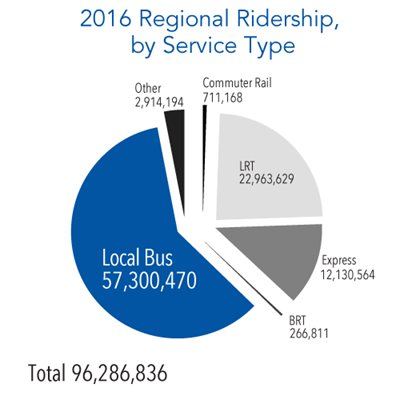Demand for Metro Mobility transit service in the Twin Cities metro area increased nearly 6% to 2.23 million rides in 2016. That continues a trend of annual growth of 5% to 8% that is expected to continue well into the future.
 In a year when ridership on many services declined at least slightly, Metro Mobility and Transit Link both gained riders.
In a year when ridership on many services declined at least slightly, Metro Mobility and Transit Link both gained riders.
“The number of adults over 65 will double by the year 2030, and as our population ages the demand for Metro Mobility services will continue to grow with it,” said Council Chair Adam Duininck. “The challenge for the region is to find the resources to continue offering quality service that meets this growing need.”
Metro Mobility is on-demand service for people with disabilities, and is mandated under the federal Americans with Disabilities Act as well as state law. Riders must be certified for eligibility. Transit Link is dial-a-ride service for the general public outside the area where fixed-route service is provided. Transit Link ridership is small when compared with most other regional transit services (302,667 rides in 2016) but demand grew 4.4% from the previous year.
Overall ridership down 2.6%, but third highest in 60 years
Metropolitan Council Transportation Services (MTS) compiles data about transit ridership across the seven-county region, from Metro Transit’s bus and rail service to suburban providers’ local and express bus service, to more specialized services.
Overall, ridership in 2016 across transit types and providers declined 2.6% from 2015 – from 98.8 million to 96.3 million. Nonetheless, it was the third highest number of transit trips regionwide in the last 60 years.
 Local bus service is by far the largest component of regional ridership. Local ridership totaled 57.3 million in 2016, down 4.4% from the previous year. Express ridership edged up ever so slightly (.02%) to 12.2 million.
Local bus service is by far the largest component of regional ridership. Local ridership totaled 57.3 million in 2016, down 4.4% from the previous year. Express ridership edged up ever so slightly (.02%) to 12.2 million.
The low price of gas was one factor in declining ridership.
A Line rapid bus hits 1 million rides less than a year after opening
The new A Line rapid bus service bucked the trend, racking up one million rides by February, after less than a year of service. Rapid bus offers high frequency service, running every 10 minutes; and limited stops, resulting in travel times up to 25% faster than regular, local bus service. Enhanced amenities like heated and lit bus shelters, with real-time arrival and departure displays and WiFi service on the buses has drawn in more riders. Overall ridership on all modes of transit along the A Line corridor on Snelling Avenue and Ford Parkway has increased by 33%.
“By offering better, faster service we’re attracting new riders to transit at a time when gas prices are low and many people are choosing to drive,” Duininck said. “Because we are committed to high quality service, our ridership numbers remained historically high.”
Another bright spot: ridership on the METRO Green Line (LRT) rose for the second straight year, finishing with 12.7 million rides, a 2.5% increase. Ridership on the METRO Blue Line declined just .2% to 10.3 million.